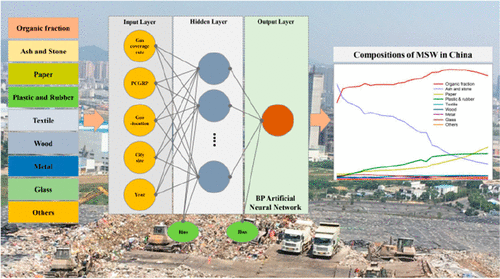当前位置:
X-MOL 学术
›
Environ. Sci. Technol.
›
论文详情
Our official English website, www.x-mol.net, welcomes your
feedback! (Note: you will need to create a separate account there.)
Estimating Physical Composition of Municipal Solid Waste in China by Applying Artificial Neural Network Method.
Environmental Science & Technology ( IF 10.8 ) Pub Date : 2020-07-06 , DOI: 10.1021/acs.est.0c01802 Shijun Ma 1, 2 , Chuanbin Zhou 1, 2 , Ce Chi 3 , Yijie Liu 1 , Guang Yang 1, 2
Environmental Science & Technology ( IF 10.8 ) Pub Date : 2020-07-06 , DOI: 10.1021/acs.est.0c01802 Shijun Ma 1, 2 , Chuanbin Zhou 1, 2 , Ce Chi 3 , Yijie Liu 1 , Guang Yang 1, 2
Affiliation

|
Physical composition of municipal solid waste (PCMSW) is the fundamental parameter in domestic waste management; however, high fidelity, wide coverage, upscaling, and year continuous data sets of PCMSW in China are insufficient. A traceable and predictable methodology for estimating PCMSW in China is established for the first time by analyzing 503 PCMSW data sets of 135 prefecture-level cities in China. A hyperspherical transformation method was used to eliminate the constant sum constraint in statistically analyzing PCMSW data. Moreover, a back-propagation (BP) neural network methodology was applied to establish quantitative models between city-level PCMSW and its socio-economic factors, including city size, per capita gross regional product, geographical location, gas coverage rate, and year. Results show that (1) national-level PCMSW in 2017 was estimated as organic fraction (53.7%), ash and stone (8.3%), paper (16.9%), plastic and rubber (13.6%), textile (2.3%), wood (2.2%), metal (0.6%), glass (1.5%), and others (1.0%); (2) organic fraction, paper, and plastics showed an increasing trend from 1990 to 2017, while ash and stone decreased significantly; (3) organic fractions in East, North, and Central-South China were higher than those in other regions. This enables us to fill the data gap in the practice of municipal solid waste management in China.
更新日期:2020-08-04











































 京公网安备 11010802027423号
京公网安备 11010802027423号